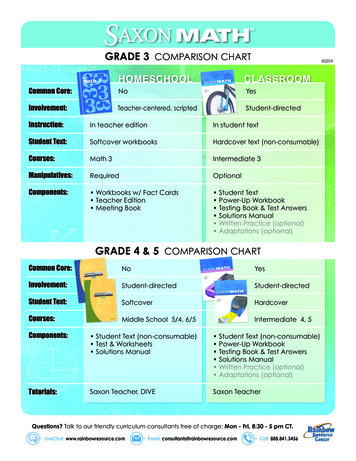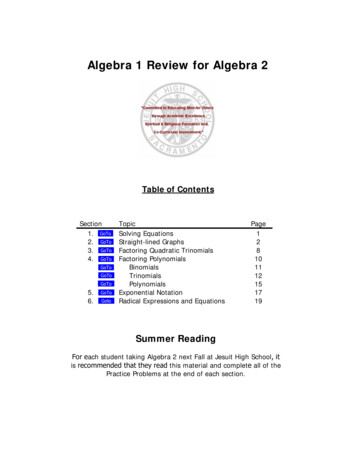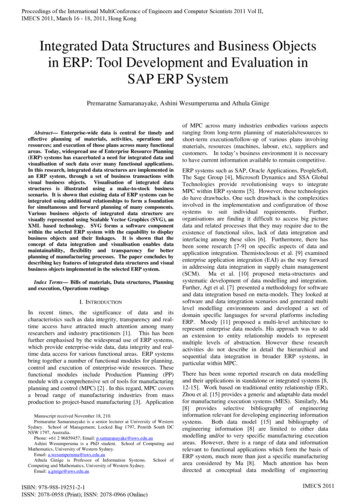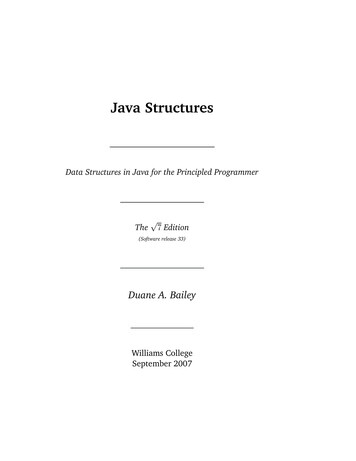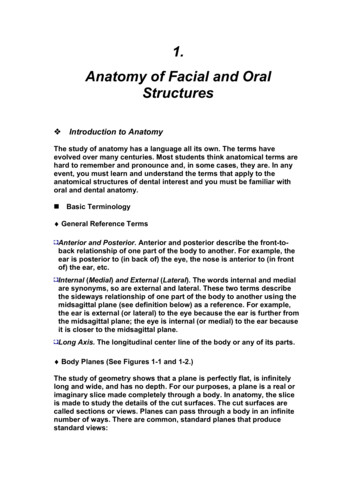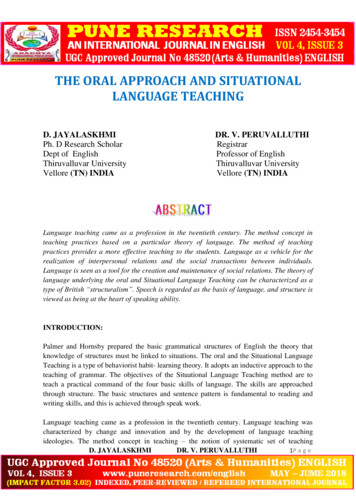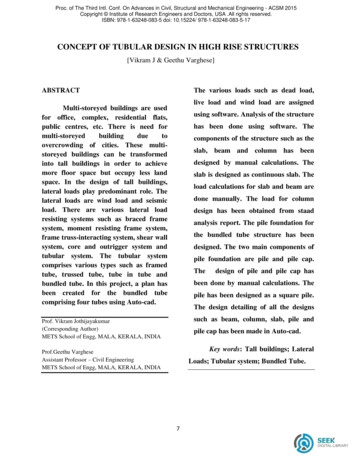
Transcription
Data Structures and AlgorithmsDSAAnnotated Reference with ExamplesGranville Barne!Luca Del Tongo
Data Structures and Algorithms:Annotated Reference with ExamplesFirst Editionc Granville Barnett, and Luca Del Tongo 2008.Copyright
This book is made exclusively available from DotNetSlackers(http://dotnetslackers.com/) the place for .NET articles, and news fromsome of the leading minds in the software industry.
Contents1 Introduction1.1 What this book is, and what it isn’t . . .1.2 Assumed knowledge . . . . . . . . . . . .1.2.1 Big Oh notation . . . . . . . . . .1.2.2 Imperative programming language1.2.3 Object oriented concepts . . . . .1.3 Pseudocode . . . . . . . . . . . . . . . . .1.4 Tips for working through the examples . .1.5 Book outline . . . . . . . . . . . . . . . .1.6 Testing . . . . . . . . . . . . . . . . . . .1.7 Where can I get the code? . . . . . . . . .1.8 Final messages . . . . . . . . . . . . . . .I.Data Structures2 Linked Lists2.1 Singly Linked List . . . . .2.1.1 Insertion . . . . . . .2.1.2 Searching . . . . . .2.1.3 Deletion . . . . . . .2.1.4 Traversing the list .2.1.5 Traversing the list in2.2 Doubly Linked List . . . . .2.2.1 Insertion . . . . . . .2.2.2 Deletion . . . . . . .2.2.3 Reverse Traversal . .2.3 Summary . . . . . . . . . .1111344667778.9910101112131315151617. . . . . . . . . . . . . . . . . . . . . . . . . . . . . . . . . . . . . . . . . . . . . . . . . . . . . . . . . . . . . . . . . . . . . . .in the binary search tree. . . . . . . . . . . . . . . . . . . . . . . . . . . . .192021222424252626. . . . . . . . . . . . . . . . . . . . . . . . . . . . . . . . . . . .reverse order. . . . . . . . . . . . . . . . . . . . . . . . . . . . . . . . . . . .3 Binary Search Tree3.1 Insertion . . . . . . . . . . . . . . . . .3.2 Searching . . . . . . . . . . . . . . . .3.3 Deletion . . . . . . . . . . . . . . . . .3.4 Finding the parent of a given node . .3.5 Attaining a reference to a node . . . .3.6 Finding the smallest and largest values3.7 Tree Traversals . . . . . . . . . . . . .3.7.1 Preorder . . . . . . . . . . . . .I.
3.83.7.2 Postorder . .3.7.3 Inorder . . .3.7.4 Breadth FirstSummary . . . . . .4 Heap4.1 Insertion .4.2 Deletion .4.3 Searching4.4 Traversal4.5 Summary.26293031.3233373841425 Sets5.1 Unordered . . . .5.1.1 Insertion .5.2 Ordered . . . . .5.3 Summary . . . .44464647476 Queues6.1 A standard queue . .6.2 Priority Queue . . .6.3 Double Ended Queue6.4 Summary . . . . . .48494949537 AVL Tree7.1 Tree Rotations .7.2 Tree Rebalancing7.3 Insertion . . . . .7.4 Deletion . . . . .7.5 Summary . . . .545657585961II.Algorithms8 Sorting8.1 Bubble Sort .8.2 Merge Sort .8.3 Quick Sort . .8.4 Insertion Sort8.5 Shell Sort . .8.6 Radix Sort .8.7 Summary . .62.63636365676868709 Numeric729.1 Primality Test . . . . . . . . . . . . . . . . . . . . . . . . . . . . 729.2 Base conversions . . . . . . . . . . . . . . . . . . . . . . . . . . . 729.3 Attaining the greatest common denominator of two numbers . . 739.4 Computing the maximum value for a number of a specific baseconsisting of N digits . . . . . . . . . . . . . . . . . . . . . . . . . 749.5 Factorial of a number . . . . . . . . . . . . . . . . . . . . . . . . 749.6 Summary . . . . . . . . . . . . . . . . . . . . . . . . . . . . . . . 75II
10 Searching7610.1 Sequential Search . . . . . . . . . . . . . . . . . . . . . . . . . . . 7610.2 Probability Search . . . . . . . . . . . . . . . . . . . . . . . . . . 7610.3 Summary . . . . . . . . . . . . . . . . . . . . . . . . . . . . . . . 7711 Strings11.1 Reversing the order of words in a sentence . . . . . . . . . . .11.2 Detecting a palindrome . . . . . . . . . . . . . . . . . . . . .11.3 Counting the number of words in a string . . . . . . . . . . .11.4 Determining the number of repeated words within a string . .11.5 Determining the first matching character between two strings11.6 Summary . . . . . . . . . . . . . . . . . . . . . . . . . . . . .79798081838485A Algorithm Walkthrough86A.1 Iterative algorithms . . . . . . . . . . . . . . . . . . . . . . . . . 86A.2 Recursive Algorithms . . . . . . . . . . . . . . . . . . . . . . . . . 88A.3 Summary . . . . . . . . . . . . . . . . . . . . . . . . . . . . . . . 90B Translation Walkthrough91B.1 Summary . . . . . . . . . . . . . . . . . . . . . . . . . . . . . . . 92C Recursive Vs. Iterative Solutions93C.1 Activation Records . . . . . . . . . . . . . . . . . . . . . . . . . . 94C.2 Some problems are recursive in nature . . . . . . . . . . . . . . . 95C.3 Summary . . . . . . . . . . . . . . . . . . . . . . . . . . . . . . . 95D TestingD.1 What constitutes a unit test? .D.2 When should I write my tests?D.3 How seriously should I view myD.4 The three A’s . . . . . . . . . .D.5 The structuring of tests . . . .D.6 Code Coverage . . . . . . . . .D.7 Summary . . . . . . . . . . . .E Symbol Definitions. . . . . . . . . . .test suite?. . . . . . . . . . . . . . . . . . . . .97. 97. 98. 99. 99. 99. 100. 100101III
PrefaceEvery book has a story as to how it came about and this one is no different,although we would be lying if we said its development had not been somewhatimpromptu. Put simply this book is the result of a series of emails sent backand forth between the two authors during the development of a library forthe .NET framework of the same name (with the omission of the subtitle ofcourse!). The conversation started off something like, “Why don’t we createa more aesthetically pleasing way to present our pseudocode?” After a fewweeks this new presentation style had in fact grown into pseudocode listingswith chunks of text describing how the data structure or algorithm in questionworks and various other things about it. At this point we thought, “What theheck, let’s make this thing into a book!” And so, in the summer of 2008 webegan work on this book side by side with the actual library implementation.When we started writing this book the only things that we were sure aboutwith respect to how the book should be structured were:1. always make explanations as simple as possible while maintaining a moderately fine degree of precision to keep the more eager minded reader happy;and2. inject diagrams to demystify problems that are even moderatly challengingto visualise (. . . and so we could remember how our own algorithms workedwhen looking back at them!); and finally3. present concise and self-explanatory pseudocode listings that can be portedeasily to most mainstream imperative programming languages like C ,C#, and Java.A key factor of this book and its associated implementations is that allalgorithms (unless otherwise stated) were designed by us, using the theory ofthe algorithm in question as a guideline (for which we are eternally grateful totheir original creators). Therefore they may sometimes turn out to be worsethan the “normal” implementations—and sometimes not. We are two fellowsof the opinion that choice is a great thing. Read our book, read several otherson the same subject and use what you see fit from each (if anything) whenimplementing your own version of the algorithms in question.Through this book we hope that you will see the absolute necessity of understanding which data structure or algorithm to use for a certain scenario. In allprojects, especially those that are concerned with performance (here we applyan even greater emphasis on real-time systems) the selection of the wrong datastructure or algorithm can be the cause of a great deal of performance pain.IV
VTherefore it is absolutely key that you think about the run time complexity andspace requirements of your selected approach. In this book we only explain thetheoretical implications to consider, but this is for a good reason: compilers arevery different in how they work. One C compiler may have some amazingoptimisation phases specifically targeted at recursion, another may not, for example. Of course this is just an example but you would be surprised by howmany subtle differences there are between compilers. These differences whichmay make a fast algorithm slow, and vice versa. We could also factor in thesame concerns about languages that target virtual machines, leaving all theactual various implementation issues to you given that you will know your language’s compiler much better than us.well in most cases. This has resulted ina more concise book that focuses on what we think are the key issues.One final note: never take the words of others as gospel; verify all that canbe feasibly verified and make up your own mind.We hope you enjoy reading this book as much as we have enjoyed writing it.Granville BarnettLuca Del Tongo
AcknowledgementsWriting this short book has been a fun and rewarding experience. We wouldlike to thank, in no particular order the following people who have helped usduring the writing of this book.Sonu Kapoor generously hosted our book which when we released the firstdraft received over thirteen thousand downloads, without his generosity thisbook would not have been able to reach so many people. Jon Skeet provided uswith an alarming number of suggestions throughout for which we are eternallygrateful. Jon also edited this book as well.We would also like to thank those who provided the odd suggestion via emailto us. All feedback was listened to and you will no doubt see some contentinfluenced by your suggestions.A special thank you also goes out to those who helped publicise this bookfrom Microsoft’s Channel 9 weekly show (thanks Dan!) to the many bloggerswho helped spread the word. You gave us an audience and for that we areextremely grateful.Thank you to all who contributed in some way to this book. The programming community never ceases to amaze us in how willing its constituents are togive time to projects such as this one. Thank you.VI
About the AuthorsGranville BarnettGranville is currently a Ph.D candidate at Queensland University of Technology(QUT) working on parallelism at the Microsoft QUT eResearch Centre1 . He alsoholds a degree in Computer Science, and is a Microsoft MVP. His main interestsare in programming languages and compilers. Granville can be contacted viaone of two places: either his personal website (http://gbarnett.org) or hisblog (http://msmvps.com/blogs/gbarnett).Luca Del TongoLuca is currently studying for his masters degree in Computer Science at Florence. His main interests vary from web development to research fields such asdata mining and computer vision. Luca also maintains an Italian blog whichcan be found at http://blogs.ugidotnet.org/wetblog/.1 http://www.mquter.qut.edu.au/VII
Page intentionally left blank.
Chapter 1Introduction1.1What this book is, and what it isn’tThis book provides implementations of common and uncommon algorithms inpseudocode which is language independent and provides for easy porting to mostimperative programming languages. It is not a definitive book on the theory ofdata structures and algorithms.For the most part this book presents implementations devised by the authorsthemselves based on the concepts by which the respective algorithms are basedupon so it is more than possible that our implementations differ from thoseconsidered the norm.You should use this book alongside another on the same subject, but onethat contains formal proofs of the algorithms in question. In this book we usethe abstract big Oh notation to depict the run time complexity of algorithmsso that the book appeals to a larger audience.1.2Assumed knowledgeWe have written this book with few assumptions of the reader, but some havebeen necessary in order to keep the book as concise and approachable as possible.We assume that the reader is familiar with the following:1. Big Oh notation2. An imperative programming language3. Object oriented concepts1.2.1Big Oh notationFor run time complexity analysis we use big Oh notation extensively so it is vitalthat you are familiar with the general concepts to determine which is the bestalgorithm for you in certain scenarios. We have chosen to use big Oh notationfor a few reasons, the most important of which is that it provides an abstractmeasurement by which we can judge the performance of algorithms withoutusing mathematical proofs.1
CHAPTER 1. INTRODUCTION2Figure 1.1: Algorithmic run time expansionFigure 1.1 shows some of the run times to demonstrate how important it is tochoose an efficient algorithm. For the sanity of our graph we have omitted cubicO(n3 ), and exponential O(2n ) run times. Cubic and exponential algorithmsshould only ever be used for very small problems (if ever!); avoid them if feasiblypossible.The following list explains some of the most common big Oh notations:O(1) constant: the operation doesn’t depend on the size of its input, e.g. addinga node to the tail of a linked list where we always maintain a pointer tothe tail node.O(n) linear: the run time complexity is proportionate to the size of n.O(log n) logarithmic: normally associated with algorithms that break the probleminto smaller chunks per each invocation, e.g. searching a binary searchtree.O(n log n) just n log n: usually associated with an algorithm that breaks the probleminto smaller chunks per each invocation, and then takes the results of thesesmaller chunks and stitches them back together, e.g. quick sort.O(n2 ) quadratic: e.g. bubble sort.O(n3 ) cubic: very rare.O(2n ) exponential: incredibly rare.If you encounter either of the latter two items (cubic and exponential) this isreally a signal for you to review the design of your algorithm. While prototyping algorithm designs you may just have the intention of solving the problemirrespective of how fast it works. We would strongly advise that you alwaysreview your algorithm design and optimise where possible—particularly loops
CHAPTER 1. INTRODUCTION3and recursive calls—so that you can get the most efficient run times for youralgorithms.The biggest asset that big Oh notation gives us is that it allows us to essentially discard things like hardware. If you have two sorting algorithms, onewith a quadratic run time, and the other with a logarithmic run time then thelogarithmic algorithm will always be faster than the quadratic one when thedata set becomes suitably large. This applies even if the former is ran on a machine that is far faster than the latter. Why? Because big Oh notation isolatesa key factor in algorithm analysis: growth. An algorithm with a quadratic runtime grows faster than one with a logarithmic run time. It is generally said atsome point as n the logarithmic algorithm will become faster than thequadratic algorithm.Big Oh notation also acts as a communication tool. Picture the scene: youare having a meeting with some fellow developers within your product group.You are discussing prototype algorithms for node discovery in massive networks.Several minutes elapse after you and two others have discussed your respectivealgorithms and how they work. Does this give you a good idea of how fast eachrespective algorithm is? No. The result of such a discussion will tell you moreabout the high level algorithm design rather than its efficiency. Replay the sceneback in your head, but this time as well as talking about algorithm design eachrespective developer states the asymptotic run time of their algorithm. Usingthe latter approach you not only get a good general idea about the algorithmdesign, but also key efficiency data which allows you to make better choiceswhen it comes to selecting an algorithm fit for purpose.Some readers may actually work in a product group where they are givenbudgets per feature. Each feature holds with it a budget that represents its uppermost time bound. If you save some time in one feature it doesn’t necessarilygive you a buffer for the remaining features. Imagine you are working on anapplication, and you are in the team that is developing the routines that willessentially spin up everything that is required when the application is started.Everything is great until your boss comes in and tells you that the start uptime should not exceed n ms. The efficiency of every algorithm that is invokedduring start up in this example is absolutely key to a successful product. Evenif you don’t have these budgets you should still strive for optimal solutions.Taking a quantitative approach for many software development propertieswill make you a far superior programmer - measuring one’s work is critical tosuccess.1.2.2Imperative programming languageAll examples are given in a pseudo-imperative coding format and so the readermust know the basics of some imperative mainstream programming languageto port the examples effectively, we have written this book with the followingtarget languages in mind:1. C 2. C#3. Java
CHAPTER 1. INTRODUCTION4The reason that we are explicit in this requirement is simple—all our implementations are based on an imperative thinking style. If you are a functionalprogrammer you will need to apply various aspects from the functional paradigmto produce efficient solutions with respect to your functional language whetherit be Haskell, F#, OCaml, etc.Two of the languages that we have listed (C# and Java) target virtualmachines which provide various things like security sand boxing, and memorymanagement via garbage collection algorithms. It is trivial to port our implementations to these languages. When porting to C you must remember touse pointers for certain things. For example, when we describe a linked listnode as having a reference to the next node, this description is in the contextof a managed environment. In C you should interpret the reference as apointer to the next node and so on. For programmers who have a fair amountof experience with their respective language these subtleties will present no issue, which is why we really do emphasise that the reader must be comfortablewith at least one imperative language in order to successfully port the pseudoimplementations in this book.It is essential that the user is familiar with primitive imperative languageconstructs before reading this book otherwise you will just get lost. Some algorithms presented in this book can be confusing to follow even for experiencedprogrammers!1.2.3Object oriented conceptsFor the most part this book does not use features that are specific to any onelanguage. In particular, we never provide data structures or algorithms thatwork on generic types—this is in order to make the samples as easy to followas possible. However, to appreciate the designs of our data structures you willneed to be familiar with the following object oriented (OO) concepts:1. Inheritance2. Encapsulation3. PolymorphismThis is especially important if you are planning on looking at the C# targetthat we have implemented (more on that in §1.7) which makes extensive useof the OO concepts listed above. As a final note it is also desirable that thereader is familiar with interfaces as the C# target uses interfaces throughoutthe sorting algorithms.1.3PseudocodeThroughout this book we use pseudocode to describe our solutions. For themost part interpreting the pseudocode is trivial as it looks very much like amore abstract C , or C#, but there are a few things to point out:1. Pre-conditions should always be enforced2. Post-conditions represent the result of applying algorithm a to data structure d
CHAPTER 1. INTRODUCTION53. The type of parameters is inferred4. All primitive language constructs are explicitly begun and endedIf an algorithm has a return type it will often be presented in the postcondition, but where the return type is sufficiently obvious it may be omittedfor the sake of brevity.Most algorithms in this book require parameters, and because we assign noexplicit type to those parameters the type is inferred from the contexts in whichit is used, and the operations performed upon it. Additionally, the name ofthe parameter usually acts as the biggest clue to its type. For instance n is apseudo-name for a number and so you can assume unless otherwise stated thatn translates to an integer that has the same number of bits as a WORD on a32 bit machine, similarly l is a pseudo-name for a list where a list is a resizeablearray (e.g. a vector).The last major point of reference is that we always explicitly end a languageconstruct. For instance if we wish to close the scope of a for loop we willexplicitly state end for rather than leaving the interpretation of when scopesare closed to the reader. While implicit scope closure works well in simple code,in complex cases it can lead to ambiguity.The pseudocode style that we use within this book is rather straightforward.All algorithms start with a simple algorithm signature, e.g.1) algorithm AlgorithmName(arg1, arg2, ., argN )2) .n) end AlgorithmNameImmediately after the algorithm signature we list any Pre or Post conditions.1) algorithm AlgorithmName(n)2)Pre: n is the value to compute the factorial of3)n 04)Post: the factorial of n has been computed5)// .n) end AlgorithmNameThe example above describes an algorithm by the name of AlgorithmName,which takes a single numeric parameter n. The pre and post conditions followthe algorithm signature; you should always enforce the pre-conditions of analgorithm when porting them to your language of choice.Normally what is listed as a pre-conidition is critical to the algorithms operation. This may cover things like the actual parameter not being null, or that thecollection passed in must contain at least n items. The post-condition mainlydescribes the effect of the algorithms operation. An example of a post-conditionmight be “The list has been sorted in ascending order”Because everything we describe is language independent you will need tomake your own mind up on how to best handle pre-conditions. For example,in the C# target we have implemented, we consider non-conformance to preconditions to be exceptional cases. We provide a message in the exception totell the caller why the algorithm has failed to execute normally.
CHAPTER 1. INTRODUCTION1.46Tips for working through the examplesAs with most books you get out what you put in and so we recommend that inorder to get the most out of this book you work through each algorithm with apen and paper to track things like variable names, recursive calls etc.The best way to work through algorithms is to set up a table, and in thattable give each variable its own column and continuously update these columns.This will help you keep track of and visualise the mutations that are occurringthroughout the algorithm. Often while working through algorithms in sucha way you can intuitively map relationships between data structures ratherthan trying to work out a few values on paper and the rest in your head. Wesuggest you put everything on paper irrespective of how trivial some variablesand calculations may be so that you always have a point of reference.When dealing with recursive algorithm traces we recommend you do thesame as the above, but also have a table that records function calls and whothey return to. This approach is a far cleaner way than drawing out an elaboratemap of function calls with arrows to one another, which gets large quickly andsimply makes things more complex to follow. Track everything in a simple andsystematic way to make your time studying the implementations far easier.1.5Book outlineWe have split this book into two parts:Part 1: Provides discussion and pseudo-implementations of common and uncommon data structures; andPart 2: Provides algorithms of varying purposes from sorting to string operations.The reader doesn’t have to read the book sequentially from beginning toend: chapters can be read independently from one another. We suggest thatin part 1 you read each chapter in its entirety, but in part 2 you can get awaywith just reading the section of a chapter that describes the algorithm you areinterested in.Each of the chapters on data structures present initially the algorithms concerned with:1. Insertion2. Deletion3. SearchingThe previous list represents what we believe in the vast majority of cases tobe the most important for each respective data structure.For all readers we recommend that before looking at any algorithm youquickly look at Appendix E which contains a table listing the various symbolsused within our algorithms and their meaning. One keyword that we would liketo point out here is yield. You can think of yield in the same light as return.The return keyword causes the method to exit and returns control to the caller,whereas yield returns each value to the caller. With yield control only returnsto the caller when all values to return to the caller have been exhausted.
CHAPTER 1. INTRODUCTION1.67TestingAll the data structures and algorithms have been tested using a minimised testdriven development style on paper to flesh out the pseudocode algorithm. Wethen transcribe these tests into unit tests satisfying them one by one. Whenall the test cases have been progressively satisfied we consider that algorithmsuitably tested.For the most part algorithms have fairly obvious cases which need to besatisfied. Some however have many areas which can prove to be more complexto satisfy. With such algorithms we will point out the test cases which are trickyand the corresponding portions of pseudocode within the algorithm that satisfythat respective case.As you become more familiar with the actual problem you will be able tointuitively identify areas which may cause problems for your algorithms implementation. This in some cases will yield an overwhelming list of concerns whichwill hinder your ability to design an algorithm greatly. When you are bombarded with such a vast amount of concerns look at the overall problem againand sub-divide the problem into smaller problems. Solving the smaller problemsand then composing them is a far easier task than clouding your mind with toomany little details.The only type of testing that we use in the implementation of all that isprovided in this book are unit tests. Because unit tests contribute such a corepiece of creating somewhat more stable software we invite the reader to viewAppendix D which describes testing in more depth.1.7Where can I get the code?This book doesn’t provide any code specifically aligned with it, however we doactively maintain an open source project1 that houses a C# implementation ofall the pseudocode listed. The project is named Data Structures and Algorithms(DSA) and can be found at http://codeplex.com/dsa.1.8Final messagesWe have just a few final messages to the reader that we hope you digest beforeyou embark on reading this book:1. Understand how the algorithm works first in an abstract sense; and2. Always work through the algorithms on paper to understand how theyachieve their outcomeIf you always follow these key points, you will get the most out of this book.1 All readers are encouraged to provide suggestions, feature requests, and bugs so we canfurther improve our implementations.
Part IData Structures8
Chapter 2Linked ListsLinked lists can be thought of from a high level perspective as being a seriesof nodes. Each node has at least a single pointer to the next node, and in thelast node’s case a null pointer representing that there are no more nodes in thelinked list.In DSA our implementations of linked lists always maintain head and tailpointers so that insertion at either the head or tail of the list is a constanttime operation. Random insertion is excluded from this and will be a linearoperation. As such, linked lists in DSA have the following characteristics:1. Insertion is O(1)2. Deletion is O(n)3. Searching is O(n)Out of the three operations the one that stands out is that of insertion. InDSA we chose to always maintain pointers (or more aptly references) to thenode(s) at the head and tail of the linked list and so performing a traditionalinsertion to either the front or back of the linked list is an O(1) operation. Anexception to this rule is performing an insertion before a node that is neitherthe head nor tail in a singly linked list. When the node we are inserting beforeis somewhere in the middle of the linked list (known as random insertion) thecomplexity is O(n). In order to add before the designated node we need totraverse the linked list to find that node’s current predecessor. This traversalyields an O(n) run time.This data structure is trivial, but linked lists have a few key points which attimes make them very attractive:1. the list is dynamically resized, thus it incurs no copy penalty like an arrayor vector would eventually incur; and2. insertion is O(1).2.1Singly Linked ListSingly linked lists are one of the most primitive data structures you will find inthis book. Each node that makes up a
DSA Data Structures and Alg orith ms Ann ota ted Re fer
